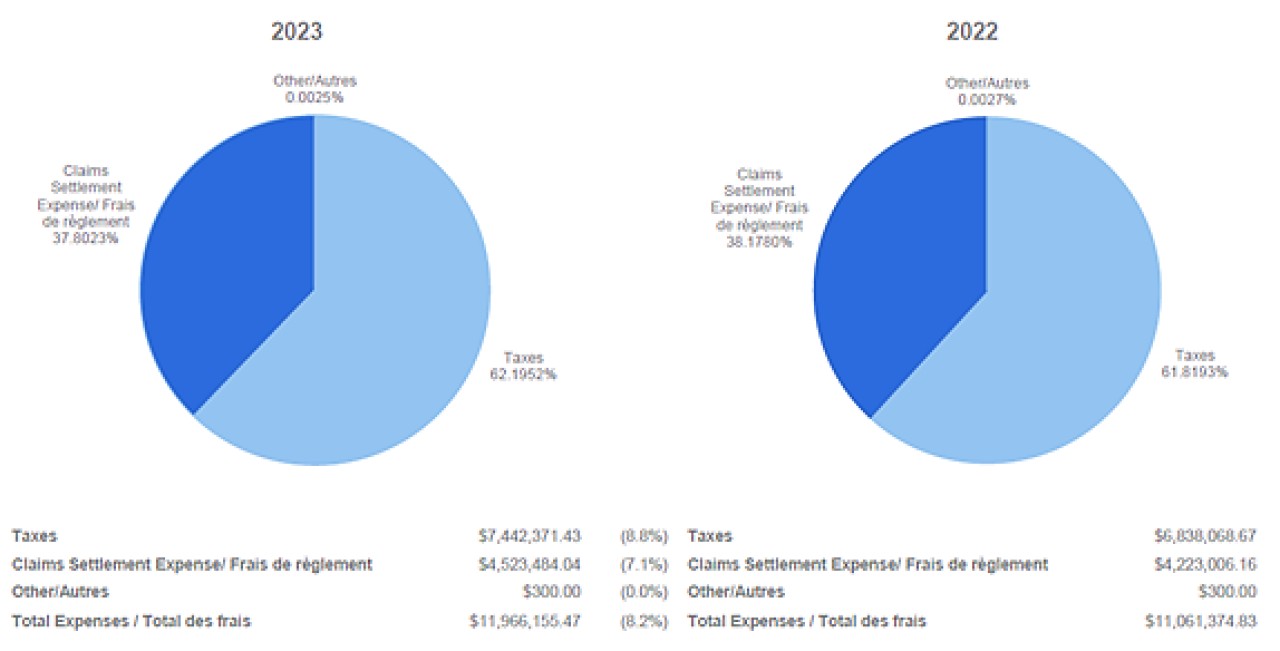January 1 to December 31, 2023
In accordance with the Dental Care Plan Board of Management (NJC part) Terms of Reference, the undersigned submit this annual report regarding the performance and the management of the Dental Care Plan (NJC Part) during the period of January 1 to December 31, 2023.
Chairperson of the Board of Management
Martin Chartier
Employer Side Members
Philippe Blanchette, Canada Revenue Agency
Hilary Flett, Health Canada
Jane Manuel, Treasury Board of Canada Secretariat
Bargaining Agent Side Members
Colby Briggs, Professional Institute of the Public Service of Canada
Paul Cameron, International Brotherhood of Electrical Workers
Joy Thomson, Canadian Merchant Service Guild
Mireille Vallière, Canadian Association of Professional Employees
General Statement
The Dental Care Plan Board of Management (NJC Part) (the Board) is pleased to present this report for the period of January 1 to December 31, 2023. The Public Service Dental Care Plan (PSDCP) completed 36 years of operation on March 1, 2023.
The Plan is intended to cover reasonable and customary dental treatment necessary to prevent or correct dental disease or defect, provided the treatment is consistent with generally accepted dental practices. The Plan is private, and its cost is fully paid by the Treasury Board of Canada Secretariat (TBS), the Employer.
The Board is composed of management and union representatives. It is responsible for the overall administration of the Plan, balancing the needs of Plan members within the allocated funding, resolving members’ complaints regarding eligibility or claims disputes, monitoring the claims settlement performance of the Administrator (Canada Life), and recommending changes to the Plan.
Administration
The Board noted that the Administrator had an average claim turnaround time of 3.32 calendar days and improved their claim turnaround time throughout 2023, ending the year with a turnaround time of 2.45 calendar days; this is less than the target turnaround time of 7 calendar days.
Regarding service level standards during 2023, the Administrator was just below their target level of 80%, answering 77.79% of calls within 60 seconds. This is a slight decrease since 2022. As the Administrator also became the service provider for the Public Service Health Care Plan (PSCHP) in 2023, there were higher than normal call volumes and wait times for the call center. However, the Administrator confirmed they have since hired a significant amount of new call-center representatives to help resolve this issue. For 2023, 72.03% of calls on the dedicated line were answered within 30 seconds. Additionally, the average abandon rate for 2023 was 4.63%. Although the abandon rate for calls on the dedicated line significantly increased (to 11.35%) during Q1-2023, they remained consistent around 3% throughout the rest of the year. Regarding first call resolution, the Administrator remained above the 93% target, sitting at 93.78%.
The Board requested that the Administrator provide data on what percentage of claims are submitted by Plan members versus the service providers. As such, Canada Life modified the quarterly reports they present to the Board to include this information. It was noted that in 2023, 80.70% of claims were submitted by the service providers and only 19.31% of claims were submitted by members themselves.
As a part of the Board’s duties, it is responsible for the overall administration of the Plan and monitoring claims settlement performance of the Administrator. As noted in the 2021 and 2022 Annual report, TBS indicated that an external claims audit of the Administrator would take place during 2022.Though this audit has yet to occur, the Board remains interested and continues to wait for said audit to take place, in order to address the Board’s outstanding questions concerning past scaling reports for children. It is anticipated that following the implementation of the new contract that a claims audit will be conducted, including the Board’s questions related to scaling for children.
The Administrator launched a newly improved website, titled My Canada Life at Work. As of Q4-2023, 72.32% of Plan members have registered for the new website.
Activities
The Board met six (6) times, via virtual and hybrid meeting formats, devoting it’s time to overseeing the administration and financial status of the Plan, resolving appeal cases, members’ complaints regarding eligibility and claims disputes and recommending improvements to the Plan. The Board reviewed 28 appeals; this is an increase of 21.7% from 2022. Of the 28 appeals, five (5) were upheld, one (1) was upheld in part, one (1) was sent back to the Plan member requesting more information, and 21 were denied. The Board has noticed a high frequency of appeals relating to crowns, which accounted for 25% of appeals reviewed this year.
The Board continued to participate in the Employer’s Observer Program, which is an informal program whereby diverse senior-level public servants are selected to participate on pension and benefits boards to develop their knowledge and experience to become an Employer representative in the future. The Board welcomed two (2) observers from the Observer program, as well as observers from the Bargaining Agent side, who attended Board meetings on a regular basis this year.
Throughout 2021 and 2022, the Board engaged in discussions regarding the desire to enter into Plan negotiations but were awaiting an official mandate from the Employer. In 2023, the Board was informed that a mandate to begin the Plan review had been officially issued. The Employer conducted a bench-making study to compare the PSDCP with other dental benefit plans on the market, to identify strengths and weaknesses of the PSDCP, and the results were presented to the Board. In the fall of 2023, Board members met with the Employer to begin the Plan review and intend to proceed with the Plan review throughout 2024.
Training
When possible, the Board participates in conferences and learning sessions held by the International Foundation of Employee Benefit Plans (IFEBP) as a means to develop Board member expertise and to stay current with trends in the dental care field. The Board remains committed to investing in the development of its members. Various Board members were able to attend three (3) conferences in 2023: the Legal and Legislative Update, the Canadian Public Sector Pension and Benefits Conference and the 56th Annual Canadian Benefits Conference. To provide the most benefit to all Board members, those who attend provide the Board with a debrief of the conference upon their return.
Plan Expenditures
The total cost of the Plan (NJC Part) since 2018 is as follows:
- 2018 - $125.2 M
- 2019 - $137.0 M
- 2020 - $112.2 M
- 2021 - $153.8 M
- 2022 - $168.1 M
- 2023 - $184.8 M
The Plan’s costs increased from 2015-2019 by 1.6%, 2.8%, 1.7%, 3.1% and 9.4% respectively. In 2020, the costs decreased by 18.1%. This drastic reduction was due to the closure of dental offices in Q2 due to the COVID pandemic. The administration expenses decreased proportionately in relation to the number of claims processed and the taxes decreased in relation to the value of paid claims and administration expenses. In 2021, the costs increased by 37.1% over 2020 or 12.3% over 2019. In 2022, the costs increased by 9.3% over 2021 or 49.8% over 2020 (keeping in mind the dental office closures in 2020). The total cost of $168.1M for 2022 includes $157M or 93.4% for paid claims and $11.1M or 6.6% for expenses.
In 2023, the costs increased by 9.9% over 2022.Total cost of $184.8M for 2023 includes $172.8M or 93.6% for paid claims and $11.9M or 6.4% for expenses. The year-to-year changes are:
- 2018 - 3.1%
- 2019 - 9.4%
- 2020 - (18.1%)
- 2021 - 37.1%
- 2022 - 9.3%
- 2023 - 9.9%
Paid Claims and Employees Covered (NJC Part)
The number of covered employees at the end of 2023 was 168,129, of which a total of 143,348 employees (85.3%) submitted at least one claim, either for themselves or an eligible dependant.
A total of 956,103 member claims were resolved, representing an increase of 8.2% over 2022.The average cost per claim in 2023 increased by 1.73% to $180.76 from 2022.The average benefit per member in 2023 increased to $1,027.93 from $985.37 (in 2022) which represents an increase of 4.3%.
Out of these 956,103 member claims, 10.86% were submitted via paper, 80.70% were submitted by the service provider and 8.45% were submitted online by the member. Overall, a total of 2,447,480 claims were handled, including claims for eligible dependents, representing an increase of 8.4% over 2022.
Figure 1
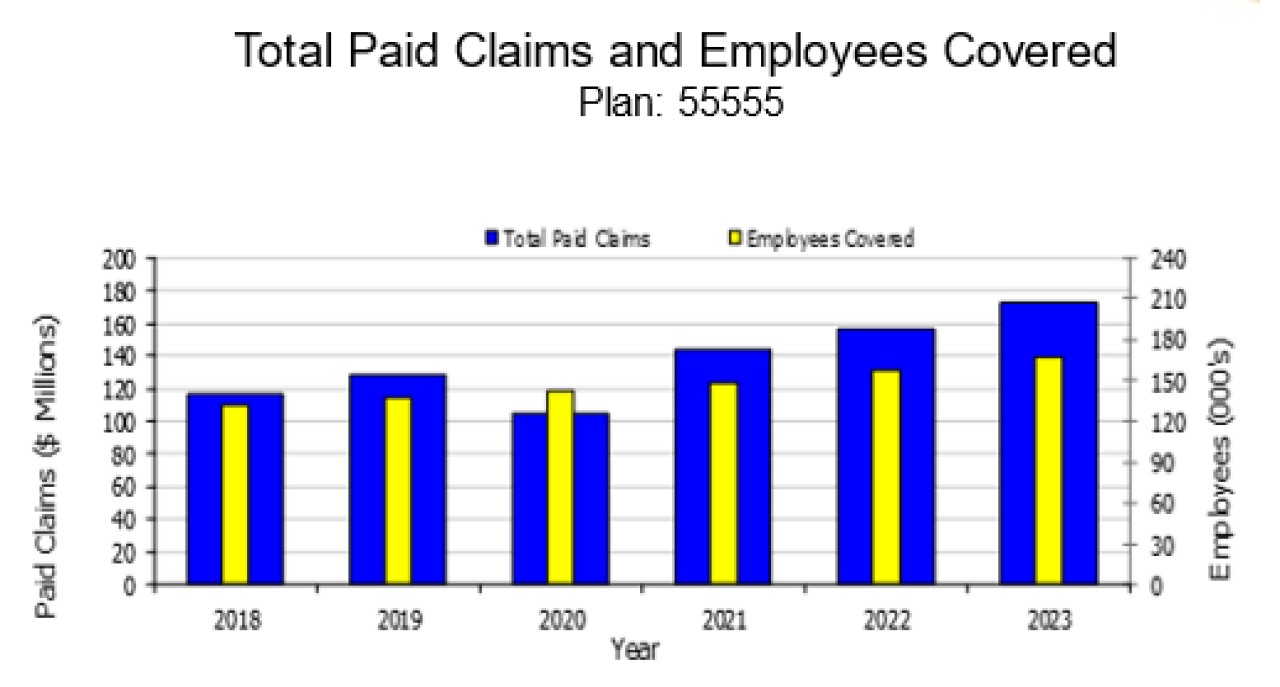
For 2023, the total amount charged by service providers to Plan members was $341,278,918 compared to $172,825,200[1] in net benefits paid to employees, for a reimbursement ratio of 50.9% (see Table 1, below).
Table 1
|
BREAKDOWN OF PAID CLAIMS |
|||||||
|---|---|---|---|---|---|---|---|
|
YEAR |
ROUTINE $ |
% |
MAJOR $ |
% |
ORTHO AMOUNT $ |
% |
TOTAL AMOUNT $ |
|
2018 |
95,601,166 |
81.8 |
10,060,075 |
8.6 |
10,545,054 |
9.6 |
116,945,533 |
|
2019 |
104,120,814 |
81.3 |
11,474,634 |
9.0 |
12,467,706 |
9.7 |
128,063,154 |
|
2020 |
84,406,432 |
80.4 |
9,522,652 |
9.1 |
11,047,849 |
10.5 |
104,976,933 |
|
2021 |
115,629,048 |
80.2 |
13,104,366 |
9.1 |
15,429,241 |
10.7 |
144,162,655 |
|
2022 |
126,353,081 |
80.4 |
13,838,140 |
8.8 |
16,892,862 |
10.8 |
157,084,083 |
|
2023 |
143,380,811 |
83.0 |
12,976,688 |
7.5 |
16,467,701 |
9.5 |
172,825,200 |
[1] Amount does not include the exchange portion of claims in US dollars.
Variations between years 2018 and 2023, concerning paid claims by type of treatment, are as follows:
Table 2
|
TREATMENT |
2018 |
2019 |
2020 |
2021 |
2022 |
2023 |
|---|---|---|---|---|---|---|
|
Major Restorative |
5.98 |
5.81 |
5.81 |
5.78 |
5.34 |
4.68 |
|
Minor Restorative |
20.96 |
20.75 |
20.75 |
20.52 |
20.00 |
20.38 |
|
Oral Surgery |
4.84 |
5.23 |
5.65 |
5.91 |
5.68 |
5.55 |
|
Orthodontic |
9.65 |
9.74 |
10.52 |
10.70 |
10.75 |
9.54 |
|
Periodontic |
24.96 |
25.00 |
24.11 |
24.97 |
25.50 |
26.57 |
|
Preventive |
12.52 |
12.04 |
10.86 |
10.47 |
10.89 |
11.36 |
|
Adjunctive |
1.23 |
1.40 |
1.49 |
1.58 |
1.57 |
1.49 |
|
Reline Rebase |
0.02 |
0.02 |
0.02 |
0.02 |
0.02 |
0.01 |
|
Dentures |
0.52 |
1.66 |
1.53 |
1.62 |
1.61 |
1.30 |
|
Diagnostic |
13.79 |
13.50 |
13.93 |
13.59 |
13.92 |
14.68 |
|
Endodontic |
3.41 |
3.35 |
3.60 |
3.15 |
2.86 |
2.91 |
|
Fixed Bridges |
2.10 |
1.50 |
1.73 |
1.39 |
1.86 |
1.53 |
TOTAL |
100 |
100 |
100 |
100 |
100 |
100 |
Table 2 (above) shows that while most percentages remained fairly stable from 2018 to 2022, there was an increase in 2023 for periodontics, preventative and diagnostic services and a decrease in orthodontics and fixed bridges. In view of the pandemic, there was a noticeable decrease in preventive services from 2020 to 2022. However, for 2023 there was an increase in preventive services almost to the levels of pre-pandemic. As for periodontics and diagnostic services, they have surpassed pre-pandemic levels.
As for orthodontics and fixed bridges, there was a decrease in utilization that is comparable to 2019.
Figure 2 (next page) represents the average amount paid by the Administrator to employees in 2023 in the various age groups. The age groups of 40-44 and 45-49 continue to have the highest amount paid per employee. The average paid amount in 2023 increased for all age categories but even more significantly for the age 35-39 group where there was an increase of 11.4% over 2022.
Figure 2
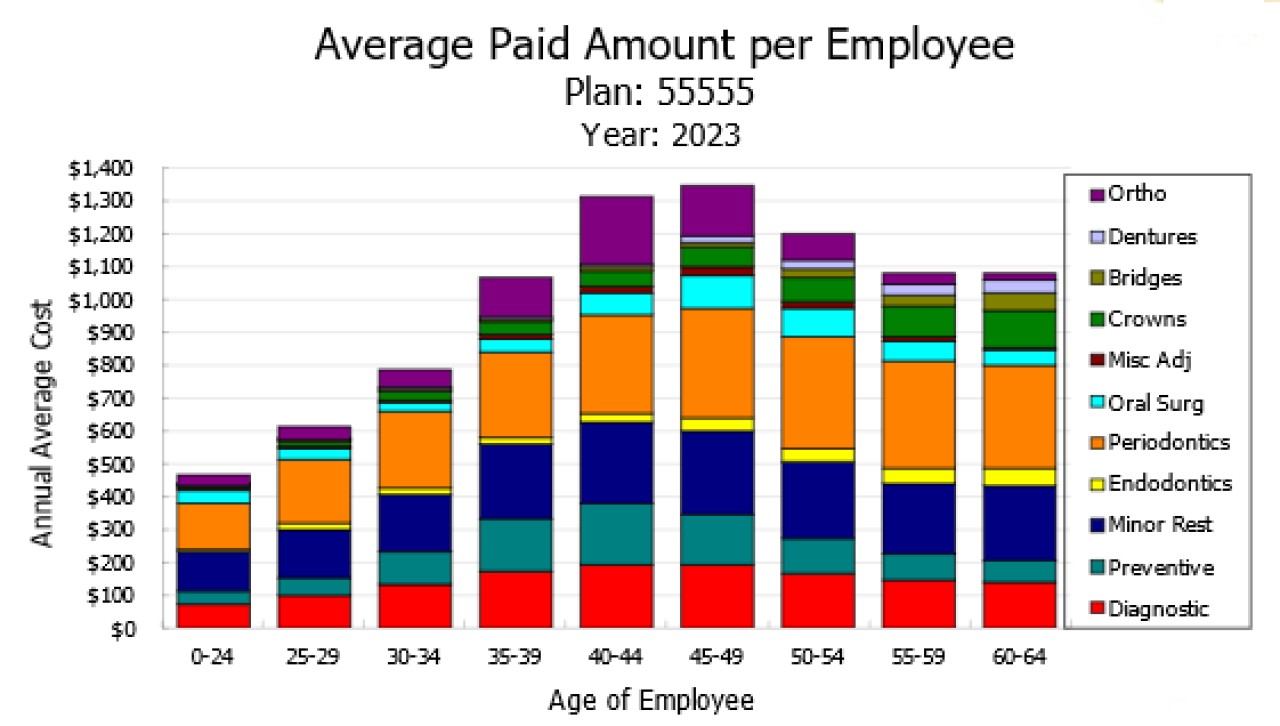
Figure 3 (below) shows that the average amount paid increased for all age categories from 2019 to 2023 but more noticeably for the 35-39 and 40-44 age group. The table also shows that the average amount increased for all services and all age categories except for some decreases in various age bands for preventive, endodontics, and orthodontics.
Figure 3
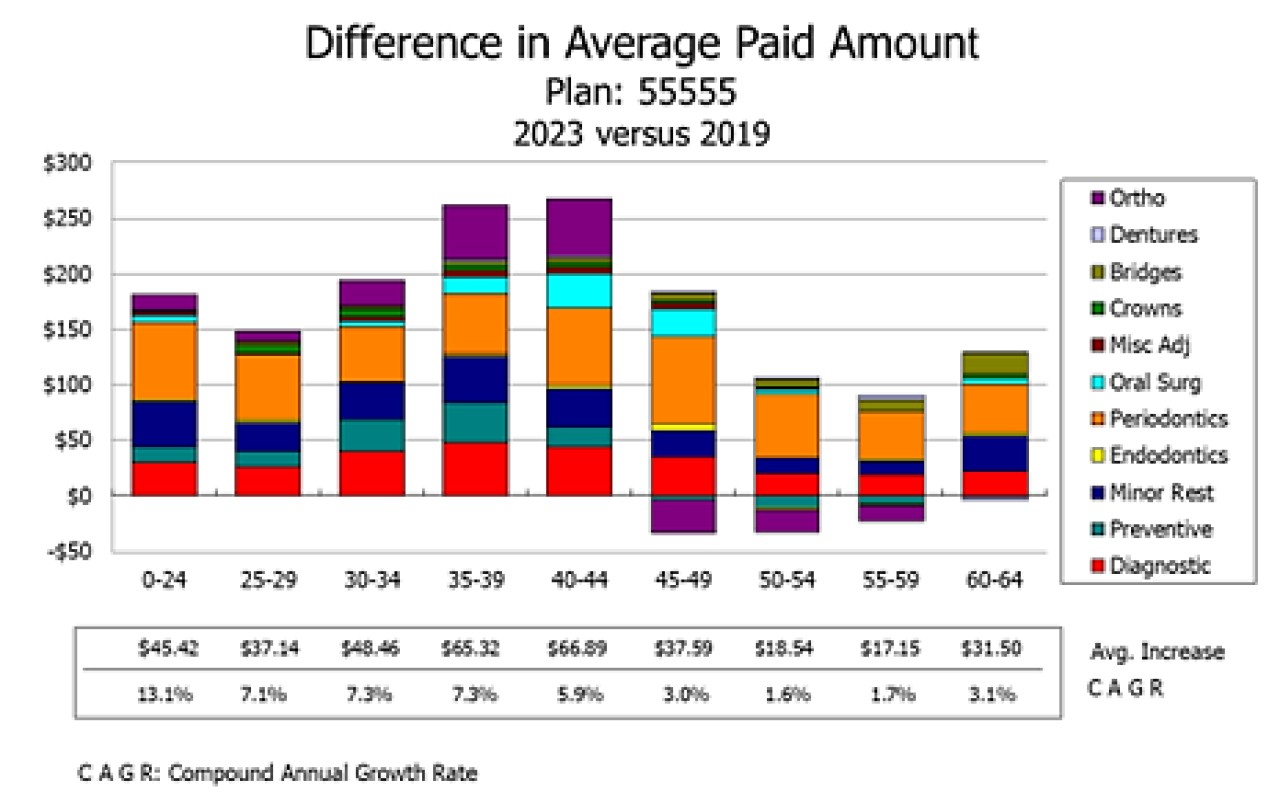
Overall, compared to 2019, the Plan showed a compound average cost increase per employee in all age bands except for preventive treatments which reduced for ages 45 and above. The majority of endodontic services increased with the exception of the 50-54 age band. Oral surgery, miscellaneous adjunctive services and crowns for the 55-59 age band saw a slight decrease in average cost. There was a decrease in average cost for dentures in the 60-64 age band and a reduction in cost for orthodontics in the 45-59 age band.
Total costs for the Dental Care Plan (NJC Part) in 2023 increased by 9.9% over 2022, driven mostly by the increase in the average amount paid per employee of 3.8% combined with an increase in membership of 6.0%.
Figure 4
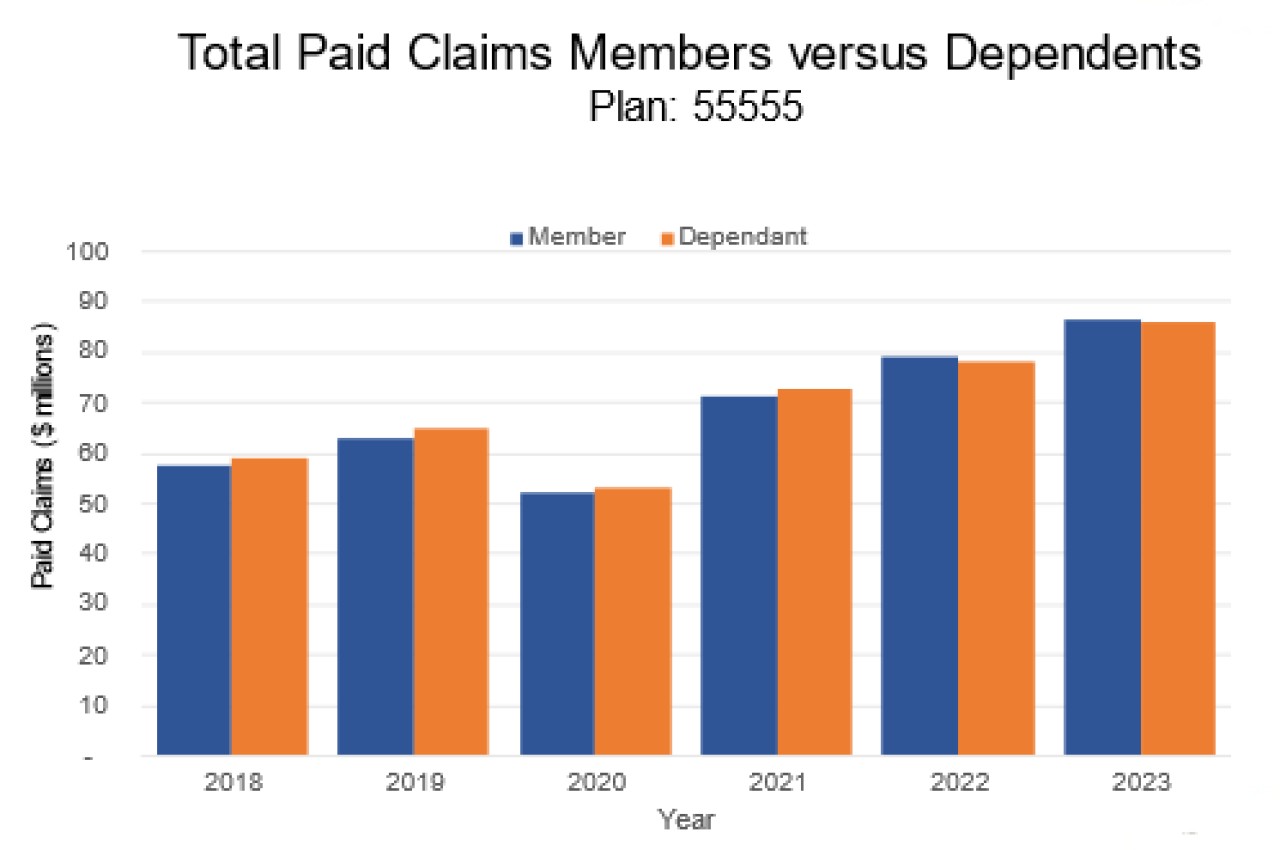
Figure 4 (above) shows increases year over year with dependent claims slightly higher than member claims each year, except for 2022 and 2023 where we saw dependent claims drop 1% lower than member claims. In 2021 & 2020 the table shows dependent claims paid were 1.7% higher than member claims, whereas in 2019 we saw dependent claims 3.3% higher than member claims.
Throughout the year, the Board continuously monitors the performance of the Plan and the level of service provided to the Plan members.
Service Level Performance Review
For 2023, the performance (Table 3, below) was as follows[2]:
Table 3
|
Targets |
Results |
|
|---|---|---|
|
Calls answered in 60 seconds or less |
|
|
|
Wait time for calls |
60 seconds or less |
111 seconds |
|
Claims turnaround time |
7 calendar days |
3.27 calendar days |
|
Abandon rate |
5% of total calls or less |
4.63% of total calls |
[2] The call centre performance is based on the results for the dedicated line only.
Currently, there are 91,983 (54.71%) NJC members registered for member portal access.
Of those registered for member portal access, 81,038 NJC members (74.43%), have elected for direct deposit. In 2023, 89.1% of total claims resolved for the PSDCP were submitted electronically.
Figure 5 (below) denotes the Plan’s operating expenses for 2023. Expenses have increased by 8.2% over 2022 with the majority of the increase as a result of claims settlement expense (7.1%).
Figure 5
PUBLIC SERVICE DENTAL CARE PLAN
OPERATING EXPENSES, 55555 PSDCP (NJC)
JANUARY 1-DECEMBER 31, 2023 vs. JANUARY 1-DECEMBER 31, 2022
Communication
Following the launch of the Compensation and Email Notification System, which is a bi-monthly email from TBS to subscribers (active employees and pensioners), email notifications were sent out to Plan members throughout 2023 to provide information and reminders regarding the Plan. When the Board notices trends in appeals, they provide TBS with suggestions on what information could be sent out to Plan members to assist them.
The emails that were sent out through the Compensation and Email Notification System in 2023 were as follows:
- The email notification in February 2023 encouraged plan members to seek pre-determinations for dental treatments more than $300 and reminded plan members that the COVID-19 temporary measures for the dental plans were ceasing.
- The email notification in April 2023 provided information on the three-year commitment for the PDSP and limitations in terminating coverage.
- The email notification in June 2023 informed new plan members about where to find plan information. PDSP information for plan members retiring soon was also included.
- The email notification in August 2023 encouraged active employees and retirees to ensure they inform the Pay Centre or Pension Centre and the Administrator of changes/updates to family status, dependents, etc.
- The email notification in October 2023 promoted awareness of the announcement in June of the new provider and reminding those retiring to update their dental coverage with their provider.
- The email notification in December 2023 reminded Plan members of the 15-month claim submission period.
On June 28, the TBS issued an Information Notice to all departments announcing the new contract award for PSDCP and PDSP to Canada Life.
Conclusion
In closing, the Board wishes to take this opportunity to thank the Administrator, Canada Life, for their contribution to the administration of the Plan in the year 2023. As always, the Board is pleased to oversee and provide advice on the management of this important employee benefit.

